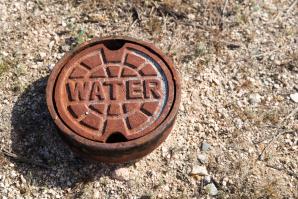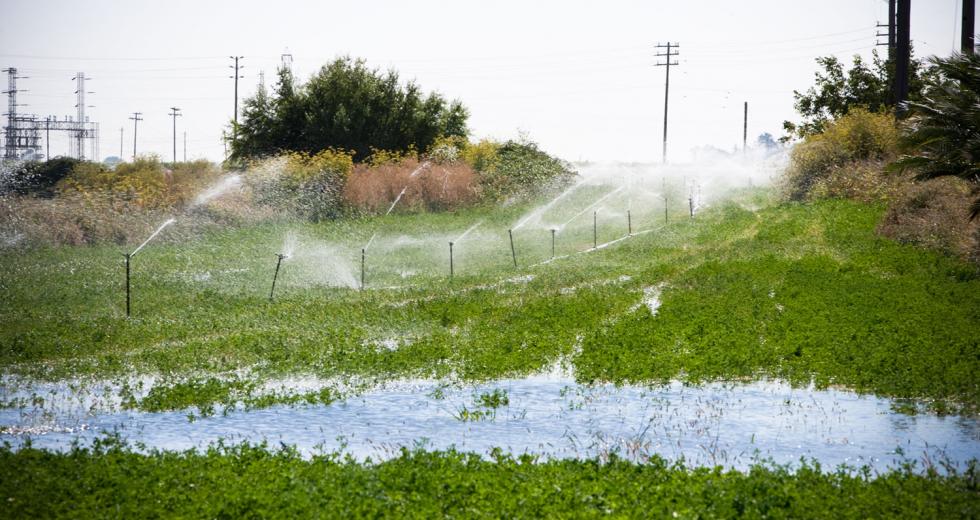This is the second installment in a four-part series on water. This month, we explore storage and conservation. Next month, we’ll examine the Sacramento-San Joaquin Delta, proposals for the peripheral canal and impacts on the environment.
For many environmentalists and residents of the Sacramento-San Joaquin Delta, the solution to California’s water supply sounds brilliant in its simplicity: Use less than we do now, particularly in areas of the state that have precious little of their own to begin with, thereby eliminating the need for spending billions of dollars on new water storage. But don’t try selling that idea to the bulk of California’s most powerful water stakeholders, many of whom contend that all the low-flow toilets and drip irrigation systems in the world won’t mean much without more dams and reservoirs to capture water during wet years and reap the benefits in dry times.
It’s a debate with no easy resolution. The best argument for conservation-only advocates is undoubtedly the cost of building new dams and reservoirs. A 2008 report from the Los Angeles County Economic Development Corp. pegged the cost of urban conservation programs in six of Southern California’s largest counties at approximately $280 per acre-foot of water over a 30-year period. An acre-foot is the amount of water needed to fill an acre a foot high, or nearly 326,000 gallons.
The estimate includes an initial $5 million capital investment and $500,000 in annual operating costs. That investment, the report says, would produce an impact equivalent to “adding more than a million acre-feet of water into the regional supply,” about 25 percent of the current annual use.
That price is significantly less than the $750 to $1,400 per acre-foot the study projects over the same time frame for water acquired from two proposed surface storage facilities in Northern California, the Sites Reservoir near Antelope Valley and Temperance Flat Reservoir on the San Joaquin River north of Fresno. Those figures include only transfer and treatment costs, and taxpayers statewide would be expected to foot a large portion of the initial capital costs via a general obligation bond. According to estimates from the Bureau of Reclamation, the two new facilities, which are still under consideration, are expected to cost more than $3 billion each to build. Temperance Flat would yield 183,000 to 208,000 acre-feet annually, while the Sites project would yield approximately 470,000 to 640,000 acre-feet.
State and federal water officials are also considering raising Shasta Dam 18.5 feet, which Bureau of Reclamation spokeswoman Shari Harrell says would allow for 636,000 additional acre-feet of storage. The proposal, which goes before Congress in 2010, is estimated to cost $825 million, most of which would be paid with federal funds.
That is a far cry, however, from what some Central Valley water districts want. The Fresno-based Westlands Water District, whose membership is composed almost entirely of Central Valley agricultural interests, wants to raise Shasta to its original design-height of 800 feet, 200 feet higher than it currently stands. Doing so would not come cheap in either fiscal or environmental terms, requiring major infrastructure projects adjacent to the dam and leading to the flooding of a large tract of pristine wilderness along the McCloud River just north of the dam. In 2007, Westlands paid $35 million for almost 3,000 acres of that land to be sure raising the dam the full 200 feet could go forward with approval from Congress. Harrell says that is highly unlikely given the ancillary costs associated with such a project.
“Eighteen feet is as high as we can raise it without rerouting Interstate 5 and moving the Pit River bridge, which will make the cost go sky-high,” Harrell says. The bureau has pegged the cost of the 200-foot addition at more than $6 billion.
John Beuttler of the California Sport Fishing Protection Alliance, a Stockton-based fisheries advocacy group, says that kind of expense, even if partially offset by federal dollars, illustrates the need for the state to focus on conservation.
“Who is going to pay for these dams?” Beuttler asks. “We know farmers don’t want to pay for them.”
Beuttler says the extreme fiscal and environmental impact of building all this new storage makes conservation a far more sensible approach to increasing the state’s water supply.
“If we had a mandatory statewide conservation policy, we wouldn’t need new dams or a [peripheral] canal,” he says. “The more we can get people to max out their own regional water supplies, the less we would need to talk about dams.”
“We cannot conserve our way out of this situation.”
Mike Wade, executive director, California Farm Water Coalition
He is not alone in his belief. A recent study from the Oakland-based California Environmental Water Caucus — an advocacy organization composed of more than two dozen environmental or fisheries groups, including Beuttler’s California Sport Fishing Protection Alliance as well as the Environmental Defense Fund, the Planning and Conservation League and the Sierra Club — goes even further, arguing that “California has already developed sufficient water supplies to take us well into this century.” The report says widespread urban conservation alone could save up to 5 million acre-feet of water annually by 2030, “enough to support a population growth of 29 million people.” That would be more than a sufficient supply given that the Department of Water Resources’ California Water Plan 2009 predicts population growth of only 28 million people over the next 40 years.
Another study released in July by the Pacific Institute, an Oakland-based nonprofit that studies water issues around the world, presents a three-tiered agricultural conservation plan that it argues would save 4.5 million acre-feet of water in wet years and 6 million acre-feet in dry years and reduce agricultural use by a total of 17 percent. The scenarios include farmers using better irrigation technologies and schedules and using less water on crops during drought-tolerant growth stages.
The Environmental Water Caucus report also advocates for stronger agricultural conservation policies, including greater conjunctive water use, mandatory measuring of all state groundwater use and cutting off all irrigation water sent to drainage-impaired farmlands in the western San Joaquin Valley.
That last one, not surprisingly, is just the kind of suggestion that makes Mike Wade, the executive director of the California Farm Water Coalition, see red. Wade, who says his group — an affiliation of agricultural water districts, farmers and farm-related businesses — wholeheartedly supports both new dams and greater agricultural conservation. He chafes at the idea of telling farmers on the west side of the Central Valley to pack it in, calling such a solution “immoral.” Wade also cites agriculture’s enormous leap in water-use efficiency the past four decades.
“Water conservation is not a new concept to farmers,” Wade says. “Farmers have always done what they can to conserve water based on the technology of the times. But we’re always playing catch-up. Even so, here in California we used 2 percent more water in 2000 than we did in 1967, but we produced 89 percent more crop volume.”
According to the U.S. Geological Survey, the majority of California crops are still watered with water-intensive spray or flood irrigation systems. Wade acknowledges this but says such practices are diminishing as technology becomes more affordable, particularly global positioning sensors that allow farmers to use micro-irrigation on a wider variety of row crops. Even so, however, Wade doesn’t buy the claim that any amount of conservation by itself can replace the need for more storage or a new conveyance method to take water around the endangered Delta.
“We cannot conserve our way out of this situation,” Wade says. California Senate Pro Tem Darrell Steinberg is among many who agree with that assertion.
“Conservation is a crucial element, but it alone is not enough,” says Steinberg, who points to the 2008 final report from Gov. Arnold Schwarzenegger’s Delta Vision Blue Ribbon Task Force that argues for, among several things, new storage facilities. “The Delta Vision blueprint is correct.”
Not even some of the most vocal conservation advocates believe it alone can solve the state’s water supply woes.
“Conservation is the cheapest, fastest and largest source of water out there and a key element in the overall solution, but it is not the only argument,” says Peter Gleick, president of the Pacific Institute. “There is no single solution.”
Although hard-core dam enthusiasts cite conservation as a key to the state’s water solution, questions remain over what such policies should look like. Much of that discord currently comes in reaction to Schwarzenegger’s plan to reduce the state’s per-capita water use 20 percent by 2020, dubbed the 20×2020 Water Conservation Plan, which the administrationsays would produce approximately 2 million acre-feet of new water annually. Nobody is openly campaigning against the plan, but many water district officials, particularly those in predominantly urban areas, believe the governor has missed the boat this time.
The San Joaquin County exhibit at the state fair caused a stir
this year. It protested the governor’s plans for a peripheral
canal in the Delta.

Chief among their concerns is the emphasis on what many local water managers consider an ill-conceived, one-size-fits-all mandate that disregards the often-tremendous differences in water availability, needs and use between California’s diverse regions.
“The parameters we were given were really more like a 30 percent reduction for this region,” says John Woodling, executive director of the Sacramento-based Regional Water Authority. “That raises a lot of questions. For one, is that really cost-effective for us here? We’re not dependent on imported water, so at what cost do we achieve 30 percent savings, and does that result in a benefit in water supply reliability here? Who benefits, and how do beneficiaries pay if you have mandated water conservation?”
There are other geographical concerns as well. For one, all water runoff does not end up in the same place. In inland areas, such as the Sacramento Region, runoff usually returns to the system, while in coastal areas that same runoff will likely head to the ocean. It is also true that water conservation policies are more likely to be effective in places where water is metered and where users pay tiered rates that reward efficiency and harshly punish waste. Many water districts also don’t appreciate the governor’s order ignoring California’s massive agriculture industry, noting that, according to the Department of Water Resources, urban use accounts for only about 11 percent of all water use in California, while farms soak up 43 percent.
Tim Quinn, executive director of the Association of California Water Agencies, which represents about 400 local and regional water districts, says his members support the goal of 20 percent use reduction but the system needs to allow flexibility for local agencies to reach that goal.
“I’m very concerned that forced conservation could harm these major industries here.”
David Okita, general manager, Solano County Water Agency
“The key is to make the program incentive-based and flexible so it can recognize differences across agencies,” Quinn says. “If you’re an agency that has already spent hundreds of millions of dollars to get the fat out of your system, nobody should be expecting a 20 percent reduction. If you’re an agency and all your return flows are going back to a stream in a wildlife refuge that is relying on those returns, you want to be careful about too much conservation.”
David Okita, general manager of the Solano County Water Agency in Elmira, doesn’t generally have too many concerns over water availability. Okita says that although Solano gets some of its water from the State Water Project, most comes from Lake Berryessa, so it is not as impacted by Delta pumping restrictions. Solano also anticipated these shortfalls years ago and has planned accordingly, working hard to achieve an acceptable balance of agriculture and development that fits with the area’s water supply. As such, Solano has been able for years to use water plentitude to attract major employers like Anheuser-Busch and Genentech Inc. Okita says the governor’s plan, along with similar bills under consideration this year in the Legislature, could send that hard-earned economic advantage swirling down the drain.
“I’m very concerned that forced conservation could harm these major industries here,” Okita says.
State Sen. Lois Wolk, who’s Fifth Senate District is composed of several areas within the Delta, including Solano, shares Okita’s concerns. “The 20×2020 plan sounds great,” Wolk says, “but only to those who don’t know the intricacies of the system.”
Wolk, who strongly supports conservation, says California has erred greatly by not accurately measuring water use, particularly of groundwater. Without it, she says, we make decisions based on presumption and not fact.
“We used to think crops like rice were major water wasters, but now we know it replenishes the aquifer. We need to measure because we need to know when something is truly wasteful and when it is not,” she says.
Chris Brown, executive director of the California Urban Water Conservation Council in Sacramento, works with more than 200 urban water districts to establish best management conservation practices. He says every community should be able to assess its own situation as well as have the benefit of a statewide framework “so everyone is on the same playing field.”
He is also aware of Sacramento’s well-documented reputation for excessive water use, noting that the onset of water meters — due in full by 2025 — will likely be the impetus for most urban dwellers to cut back use. “Southern California is usually looking at about $900 per acre-foot for their water,” he says. “You can afford a heck of a lot of conservation for that price. In Sacramento, where water is about $200 per acre-foot, you aren’t going to see as much investment in conservation. That’s the struggle here, can you convince people to change?”
For Gleick of the Pacific Institute, there is no alternative to changing our behavior. “We have to find a compromise soon,” he says. If not, he says, the debate will shift focus to a far more difficult question than whether dams are better than low-flow toilets.
“Do we just let entire ecosystems die because of our inefficient water use?” he asks. “Do we just let our agricultural community dry up? The reality is that neither of those is acceptable.”
Fair Game: Making conservation equitable when the stakes are high
The Legislature agrees the state’s water system is broken, but it’s also where the disagreement begins. As such, Senate Pro Tem Darrell Steinberg says finding a solution is his biggest priority, but a coalition of citizens and interest groups are skeptical of his proposal. They’ve held protest rallies at several locations, including the Capitol, West Sacramento and Stockton.
Steinberg’s proposal calls for a two-house panel, which began to meet in early September, and includes recommendations from Gov. Arnold Schwarzenegger’s Delta Vision Blue Ribbon Task Force and Cabinet Committee, such as requiring the state to decrease water use by 20 percent by 2020.
The goals are numerous, but the largest efforts would focus on
ecosystem restoration and rebuilding the plumbing of the
collapsing Sacramento-San Joaquin Delta. Conservation,
underground water storage, reservoirs and conveyance would likely
also be part of the package. To do that, Steinberg created an
independent governing body of political officials.
That was battle No. 1. Opponents point to a lack of “Delta
representation” on the seven-member panel. Steinberg didn’t
appoint any senators, except himself, from the Delta region, the
area directly impacted by any potential plan to build a
peripheral canal. Barbara Barrigan-Parrilla, campaign director
for Restore the Delta, says the committee has been finalized, but
this is just the beginning of closed-door tactics.
“The fincal drafts of the bills have all been done in closed sessions and last-minute changes have been added,” she says. “Access to the legislation being proposed has been very limited.”
A broad coalition of recreational and commercial fishing groups, farmers and ranchers, environmental groups and Native American tribes opposes the package’s push to construct a 48-mile peripheral canal — what they are calling “Arnold’s big ditch.”
“I really want to stress that there are more cost-effective ways to solve California’s water problems, break Delta dependence and create the water we need for California’s economy,” Barrigan-Parrilla says. “Rather than building one big pipe, we are advocating the construction of nearly 250 local water projects throughout California.”
Other arguing points will likely include who is responsible for funding the projects and where that money will come from. Any package will likely require a bond, though the scope of that effort is still unknown.
Recommended For You

Got Storage?
California can't conserve its way out of a drought
Years of drought have baked away some of the divisions inside California’s Capitol, drawing opposing parties together in an effort to find solutions to the state’s ongoing water storage and conveyance problems.

Change of Plans
Regional conservation efforts battle dwindling budgets and staff
The future of community growth in the Capital Region hinges on the fate of several habitat conservation plans slogging through the development pipeline.



